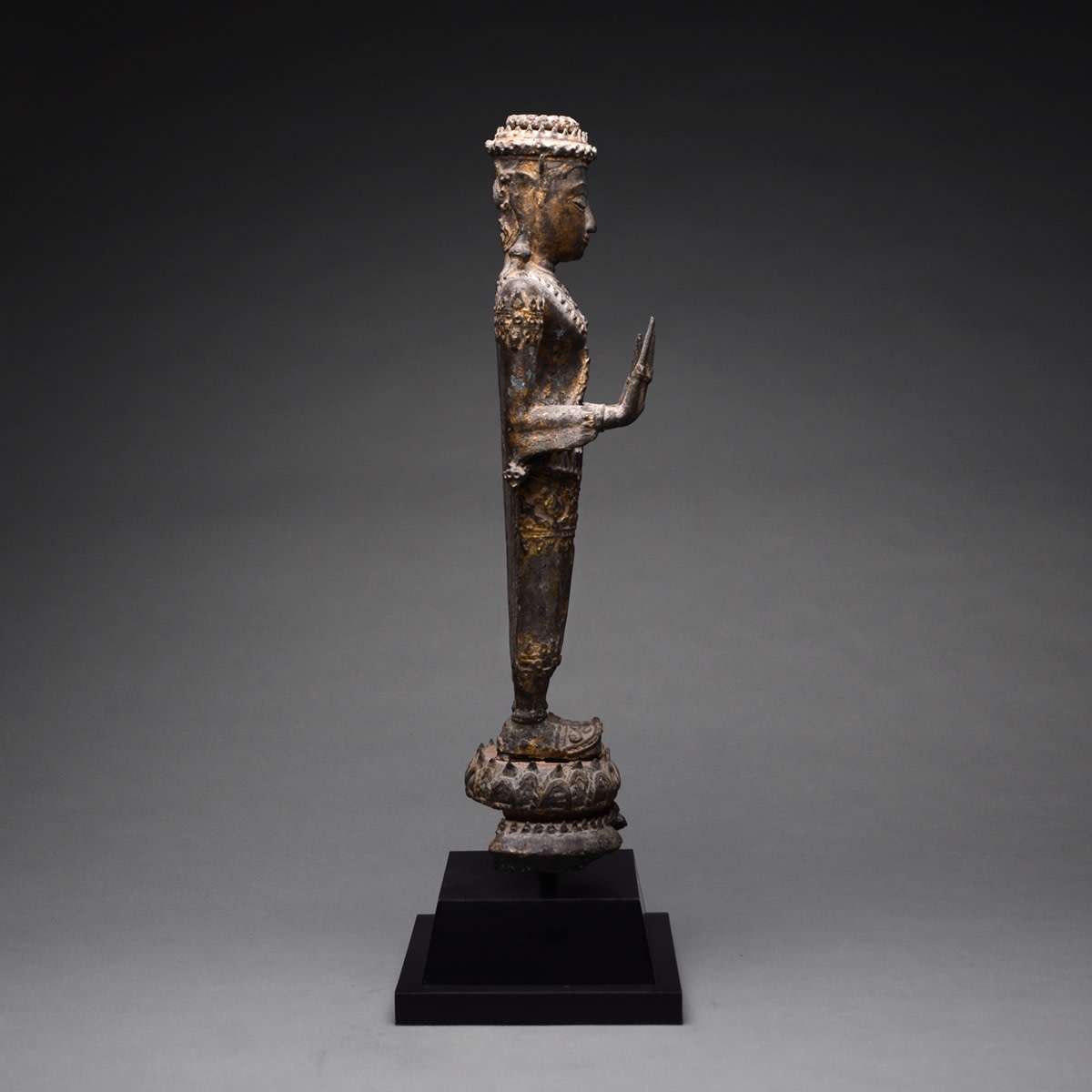Ayutthaya Bronze Sculpture of the Buddha, 1350 CE - 1564 CE
Bronze
height 47.6 cm
height 18 3/4 in
height 18 3/4 in
PF.6247
Further images
The establishment of the new kingdom of Ayutthaya in the middle of the 14th century and the change of the political center of Thai power from Sukhothai to Ayutthaya marked...
The establishment of the new kingdom of Ayutthaya in the middle of the 14th century and the change of the political center of Thai power from Sukhothai to Ayutthaya marked the beginning of a new era of great cultural prosperity. From the capital city of Ayutthaya located at the confluence of three rivers (the Chao Phraya, the Pasak, and the Lopburi) the kingdom of Ayutthaya dominated Menam Basin for over four centuries. However, it is clear that this strategic geographical and economical site had been settled by an ancient community, long before King Ramathihodi I traditionally founded the city. Ramathihodi I was a renowned warrior and lawmaker. Under his leadership, and under his immediate successors, the kingdom rapidly expanded north towards Sukhothai and east towards the Khmer capital of Angkor Wat, which they managed to seize for a brief interval. Under royal patronage, Buddhism flourished and Ayutthaya became an important Buddhist center. The rulers of this dynasty, like the rulers of the Sukhothai Kingdom, patronized cultural and religious intercourse between Sri Lanka and Thailand and encouraged and supported the development and propagation of Sihala Buddhism in Thailand. Centuries of battles with the Burmese would eventually culminate in the sacking and burning of Ayutthaya in 1767, thus ending one of the most prosperous and culturally influential periods in Thai history.
The historical figure, Buddha Gautama Sakyamuni is the Buddha of compassion who, having achieved the highest evolutionary perfection, turns suffering into happiness for all living beings. Born around 560 B.C. somewhere between the hills of south Nepal and the Rapti River, his father was a Raja who ruled over the northeastern province of India, the district including the holy Ganges River. The young prince was married to Yashoda when he was about 17 years old and together they had a son named Rahula. At the age of 29, he left his life of luxury, as he felt compelled to purify his body and make it an instrument of the mind by ridding himself of earthly impulses and temptations. Here, the Buddha stands upon a lotus pedestal, forming the double Abhaya Mudra, also known as the Gesture of Fearlessness. This hand gesture symbolizes protection, benevolence, and peace. He is dressed in full royal regalia, complete with crown, earrings, and bejeweled robe. This representation of the Buddha relates to an episode from the Mahajambupati Sutra where the Sakyamuni dresses in this regal style in order to humble a vain monarch named King Mahajambu. The general appearance associated with the Buddha characterizes him partly as a noble human being and ideal ruler and partly as superhuman.
The historical figure, Buddha Gautama Sakyamuni is the Buddha of compassion who, having achieved the highest evolutionary perfection, turns suffering into happiness for all living beings. Born around 560 B.C. somewhere between the hills of south Nepal and the Rapti River, his father was a Raja who ruled over the northeastern province of India, the district including the holy Ganges River. The young prince was married to Yashoda when he was about 17 years old and together they had a son named Rahula. At the age of 29, he left his life of luxury, as he felt compelled to purify his body and make it an instrument of the mind by ridding himself of earthly impulses and temptations. Here, the Buddha stands upon a lotus pedestal, forming the double Abhaya Mudra, also known as the Gesture of Fearlessness. This hand gesture symbolizes protection, benevolence, and peace. He is dressed in full royal regalia, complete with crown, earrings, and bejeweled robe. This representation of the Buddha relates to an episode from the Mahajambupati Sutra where the Sakyamuni dresses in this regal style in order to humble a vain monarch named King Mahajambu. The general appearance associated with the Buddha characterizes him partly as a noble human being and ideal ruler and partly as superhuman.









